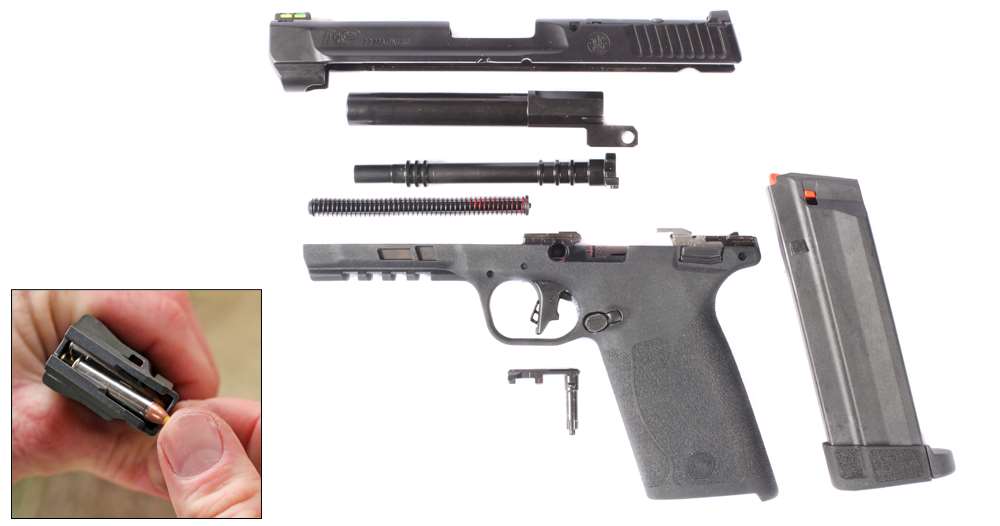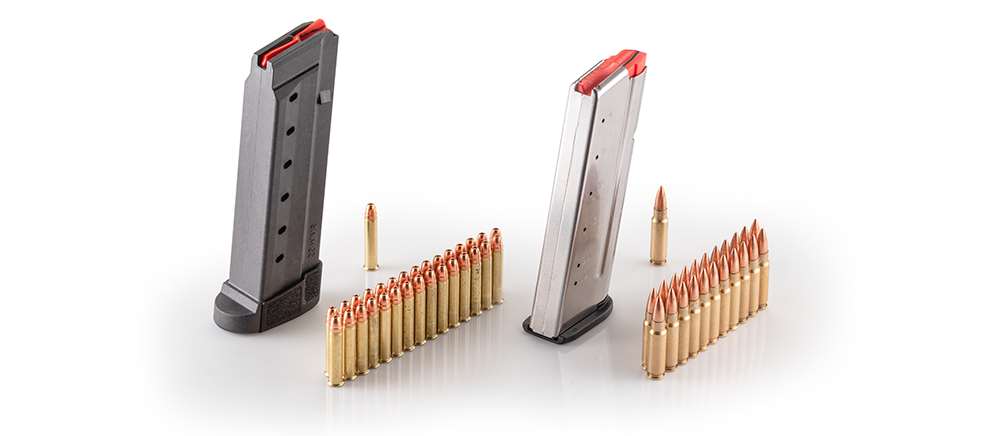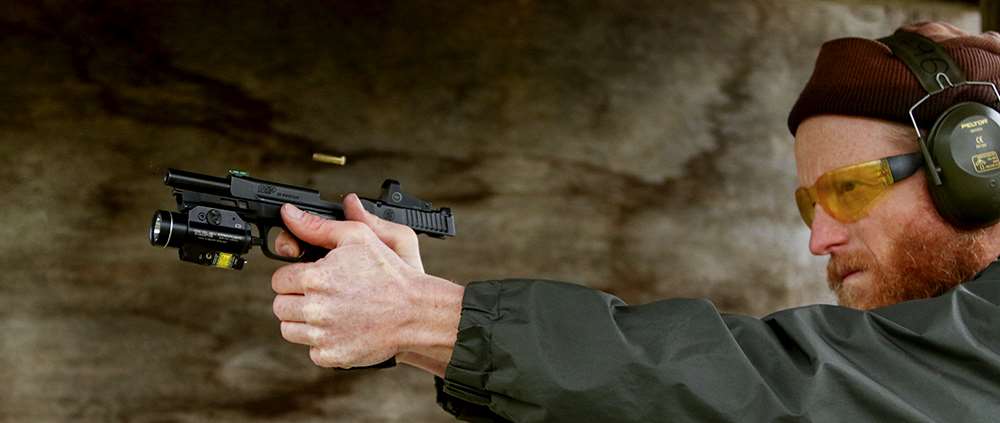The Smith & Wesson company has a history of innovation when it comes to firearm design, from its groundbreaking Model 1 revolver in 1857, to developing cartridges like the .357 Mag. and the .500 S&W Mag., to producing one of the first guns made entirely from stainless steel. These days, the company’s extensive handgun lineup is composed mainly of double-action, swing-out-cylinder revolvers and polymer-frame, semi-automatic pistols using the Browning tilting-barrel locking system—pretty conventional by modern standards. Last year, however, S&W demonstrated that it’s still willing to try something new with the announcement of a patented operating system known as Tempo and two pistol models based around it, the M&P 5.7 and M&P 22 Magnum.
The two handguns are chambered for cartridges that, until recently, have been somewhat uncommon in a semi-automatic pistol. After spending the first 25 years of its existence as an obscure, niche cartridge, the 5.7×28 mm FN has risen to prominence during the past five years, with a proliferation of both firearm and ammunition offerings. The M&P 5.7 marks S&W’s first foray into offering a firearm chambered for the cartridge.
Semi-automatic pistols chambered in .22 WMR date back to AMT’s Automag II from the mid-1980s, with occasional models appearing over the decades that followed. The .22 Mag. semi-automatic pistol has also experienced a renaissance during the past decade. While S&W has long had a well-rounded lineup of .22 WMR revolvers, from hunting to self-defense models, the M&P 22 Magnum is its first semi-automatic chambered in the magnum rimfire.
The M&P 5.7’s magazine uses a double-column design. Its 22-round magazine loads easily to capacity with the supplied tool.
On the surface, both the 5.7 and 22 Magnum look similar, taking their visual cues from the M&P semi-automatic handgun series. Their frames are polymer with a molded-in M1913 Picatinny rail section on their dustcovers. The grip texture will be familiar for those who have handled the M&P Shield series. Both the barrel and slide are made of stainless steel and finished in S&W’s Armornite nitride finish. Though they have the profile of a striker-fired pistol, both the M&P 5.7 and 22 Magnum are fired by an internal hammer, like S&W’s Shield EZ series. The pistols use a flat-faced trigger, similar to those used on some Performance Center M&P models.

Due to its rimmed cartridge, care must be taken when loading the magazine of the M&P 22 Magnum.
Though both pistols use what S&W calls the Tempo operating system, the design details of the 5.7 and 22 Magnum pistols differ. Unlike the FN, Ruger and PSA 5.7×28 mm pistols, which use delayed-blowback actions, the M&P 5.7 uses a locked-breech design. The Tempo mechanism centers around a barrel that operates within a shroud. The shroud is fixed to the frame by the spindle of the slide-release lever. When the action is closed, the breech is locked by a pair of lugs positioned above the chamber that rotate into corresponding locking surfaces in the slide.
When the pistol is fired, the breech remains locked until the bullet has passed a gas port near the muzzle. This allows a small amount of gas to be bled into the chamber formed between the barrel and the shroud, the pressure exerting force on a series of “thrust surfaces” on the barrel, pushing it rearward. As the barrel moves rearward, a cam follower situated opposite the locking lugs operates in a cam track in the shroud, causing the barrel to rotate, unlocking its lugs from the slide. The cam track halts the movement of the barrel and the unlocked slide begins to travel rearward independently to cycle the action. This movement compresses a conventional recoil spring located beneath the barrel.
While rotary-barrel designs are as old as semi-automatic handguns themselves, the 5.7’s Tempo action puts a new twist on the system. Using a rotary barrel has several potential benefits. Smith & Wesson claims the Tempo system helps to lower the pistol’s recoil impulse by turning part of the rearward force into a motion perpendicular to the line of the bore. The linear movement of the barrel (as opposed to the tilting design of Browning-type actions) theoretically directs recoil energy straight back, minimizing muzzle rise and keeping the barrel in alignment with the sights. It also allows for a lower bore axis, an additional aid in recoil management.

The M&P 5.7’s Tempo gas system uses a rotary-barrel design (l.) with two locking lugs above the chamber and a cam follower below that interacts with a groove in the barrel shroud. The barrel shroud is threaded 1/2×28 TPI to accommodate a suppressor or other muzzle device (l. middle). The pistol fires via an internal hammer (r., middle), similar to that of the S&W Shield EZ designs. A flat-faced trigger (r.) breaks cleanly at slightly less than 4 lbs.
Though S&W calls the action of the M&P 22 Magnum “locked-breech,” the system can best be described as gas-assisted blowback. While it also uses the Tempo system of a barrel with a gas port and thrust surfaces housed inside a shroud, the barrel has no lugs that lock it to the slide. When the pistol is fired, the barrel and slide begin to recoil together. As the bullet passes the gas port, a small amount of gas enters into the shroud and pressurizes it, acting on the thrust surfaces and adding additional force to the barrel’s rearward movement.
While the barrel and slide move together, the chamber stays closed until pressure has fallen to a safe level. The barrel moves in a straight line, following a straight cam track in the shroud, until its movement is arrested by stops built into the frame’s steel chassis. The slide continues its rearward movement to cycle the action. In addition to assisting in keeping the chamber closed, the “piston” effect of this system imparts extra force to the slide, helping the pistol to cycle reliably within the wide variances in rimfire ammunition.
The M&P 5.7’s 5″ barrel extends beyond the slide. As rotary-barreled designs have a tendency to unthread a suppressor as they are fired, S&W has solved this problem by threading the end of the non-rotating barrel shroud 1/2×28 TPI. The M&P 22 Magnum uses a shorter 4.35″ barrel. The barrel and shroud fit flush with the end of the slide, and there is no provision for a suppressor or other muzzle device.
The M&P 5.7 is available both with and without a manual safety, like other models in the M&P line, while the M&P 22 Magnum only comes equipped with a manual safety. Bilateral slide-release levers and safeties (if equipped) are present on both sides of the pistols. The magazine release is reversible for right- or left-handed use to make for fully ambidextrous handguns.

The S&W M&P 22 Magnum is also fired by a hammer concealed within the slide (l.). The pistol’s Tempo operating system includes a barrel that lies inside a shroud (l., middle), but unlike the M&P 5.7, it does not rotate or lock. When the chamber formed between the barrel and shroud is pressurized by gas, the barrel is forced rearward until it is stopped by the chassis (r., middle). Sights are a front post with a fiber-optic insert and a notched rear (r.); both are drift-adjustable for windage.
Sights on the M&P 5.7 are metal. The front is a post with a single white dot, while the rear is a notched blade with two white dots. Both are drift-adjustable for windage. The slide is grooved between the sights to reduce glare. The 22 Magnum has the same sighting arrangement, except the rear sight is a plain black notch, and the front post uses a fiber-optic insert. Both the 5.7 and 22 Magnum are optics-ready, with the slide cut to be compatible with the Shield footprint.
The overall size and weight of the M&P 5.7 is similar to the other “conventional,” magazine-in-grip, double-stack 5.7 mm-chambered pistols, and its 22-round magazine falls right in with those of its competition. The pistol uses a metal detachable box magazine that fits flush with the base of the grip. Despite its capacity, the grip width of the 5.7 is just slightly wider than the 9 mm single-stack M&P Shield. The magazines are a double-feed design and load to full capacity easily, especially with the supplied tool.
Including its narrow grip, the dimensions of the M&P 22 Magnum nearly duplicate those of the 5.7, though it weighs 5 ozs. less. Its 30-round magazine capacity also matches its competitors, using a polymer detachable box in which double columns of cartridges narrow into single cartridge feeding, meaning that it takes some effort to load the final cartridges into a full magazine.

Due to the small diameters of their cartridges, the M&P 22 Magnum (l.) and 5.7 (r.) magazines boast impressive 30- and 22-round capacities, respectively.
The M&P 5.7 functioned with bullets between 27 and 40 grains. Fiocchi’s 62-grain subsonic ammunition would not cycle the action when used without a suppressor. While we had no malfunctions with a clean M&P 5.7 and supersonic ammunition, once the round count reached approximately the 1,000 mark, the pistol began to have failures to fully eject the empty case or to load the next round.
Disassembling the pistol, we found most of the internal components to be very clean, with the exception of the barrel and shroud of the Tempo system. Since most of the gas and debris goes into this area, it gets extremely dirty. The area around the barrel’s gas port was especially filthy, with the type of carbon build-up you would expect to find on the tail of a direct-impingement AR-15 bolt. A similar procedure of brushing and scraping was required to remove it.
In the manual, Smith & Wesson recommends thoroughly cleaning the barrel assembly every 500 rounds, and I found this advice to be prudent. After cleaning, the pistol returned to flawless functioning, with the exception of the slide occasionally failing to lock back on an empty magazine. Accuracy averaged around 3″ for all ammunition tested.
Smith & Wesson has published a list of 17 loads that it has extensively tested in the 22 Magnum and found to function reliably. The company emphasizes that you should only use ammunition with jacketed bullets and not copper-plated or polymer-coated projectiles, as these will cause leading to foul the area between the barrel and shroud and lead to malfunctions. It will also not function with shot cartridges. As the .22 WMR uses a rimmed cartridge case, care must be taken to ensure each cartridge’s rim is placed in front of the previous one’s when loading the magazine.

The S&W M&P 22 Magnum is an accurate and low-recoiling handgun, set up to handle electronic optics and weapon lights.
I used three of the recommended cartridges in my testing. One, the Remington Magnum Rimfire, would fail to chamber with the magazine loaded to full capacity, possibly due to the semi-wadcutter-style profile of its bullet and how the first cartridges are positioned in a fully loaded magazine. Down-loading the magazine to 20 rounds tended to fix the issue, but there would still be the occasional malfunction. I have to concur with S&W’s recommendation that “before you put your M&P 22 Magnum handgun into regular use … fire several boxes of your brand of ammunition through it to determine reliability.” Accuracy averaged just more than 2″ at 25 yards with all three cartridges.
The triggers on both pistols were nearly identical, with a short take-up before hitting a wall and breaking cleanly at just under 4 lbs. for the M&P 5.7 and just over 4 lbs. for the 22 Magnum. The reset is short and positive.


Disassembling the Tempo pistols for cleaning is similar to the S&W CSX and requires a small punch. The spindle of the left-side slide release is lined up with a takedown notch in the slide and pushed through, allowing the slide assembly to be removed forward and off the frame. The recoil-spring assembly is removed, and the barrel and shroud assembly can be removed from the frame as a unit. The barrel is removed from the shroud to complete disassembly for cleaning.
Due to their similarities in dimensions, function and ballistics, the M&P 5.7 and 22 Magnum fit into similar niches. Without debating the relative merit of either cartridge for personal protection, high-quality self-defense ammunition is available for both. While larger than what most people would want to use for concealed carry, both are perfect “house guns,” augmented by their ease of mounting weapon lights and electronic sights. Along these lines, both pistols make viable close-range hunting and varmint-control firearms, again with hunting loads available in each cartridge. And while neither cartridge is inexpensive enough to be considered a plinking round, the accurate and low-recoiling pistols make for pleasant extended range sessions.
At $699 for the base model, the M&P 5.7 has an MSRP below most of its competition. The M&P 22 Magnum is priced at $649, putting it at the top end of the semi-automatic .22 WMR pistol market. Both handguns offer a unique cartridge and innovative action in the familiar M&P handgun format. At a time when it seems like the firearm world is standardizing around a few cartridges, action types and even magazine formats, it’s nice to see that historic and established manufacturers such as Smith & Wesson are willing to try marching to a different beat.


Read the full article here

